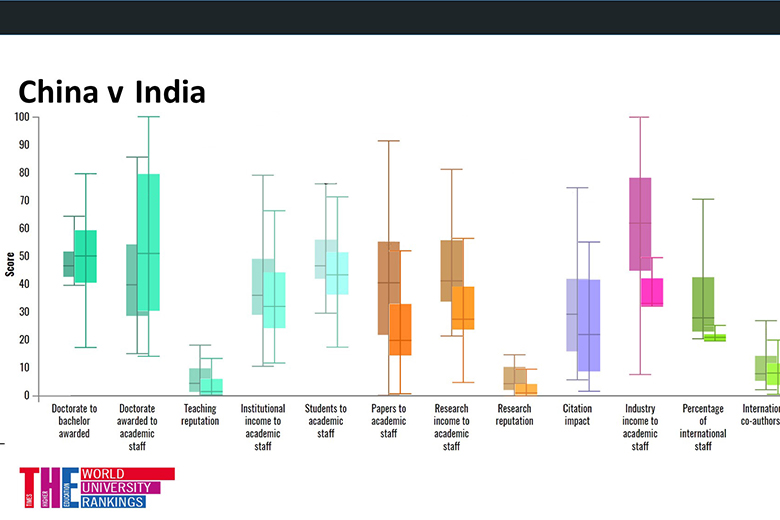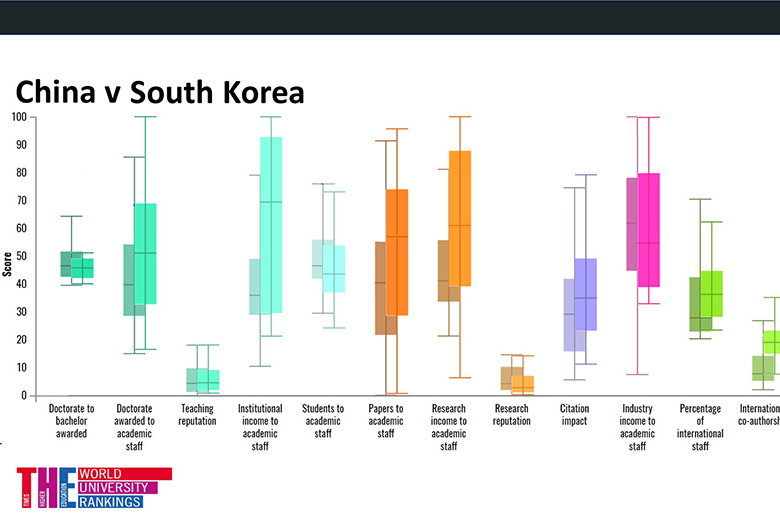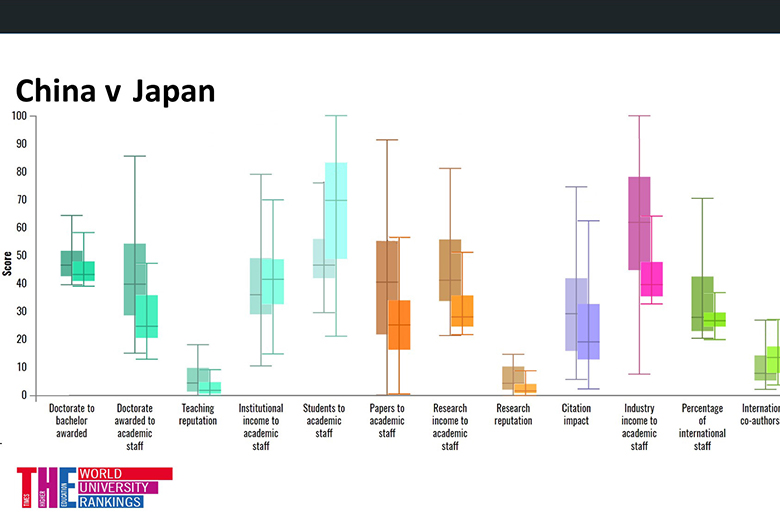China’s rise as a global economic powerhouse hardly needs an introduction. But although the performance of its elite universities has echoed this trend, the bulk of its research institutions have yet to become household names on the world stage.
In the 2016-17 Times Higher Education World University Rankings, which covered almost 1,000 institutions, mainland China (excluding Hong Kong) had 52 entries but only seven of these were in the top 400. Meanwhile, South Korea had nine universities in the top 400 despite having a fraction of the population (50 million compared with 1.3 billion), while Hong Kong (population 7 million) had six entries.
Such raw comparisons mask the fact that China is rapidly gaining ground on various measures of university performance. Delving deep into THE’s own data on Chinese universities reveals exactly where they are starting to outpace their rivals, as well as illustrating where China is still relatively lagging behind.
Three countries in particular provide useful comparisons with China: South Korea, Japan and India.
The latter illustrates most starkly how the Chinese government’s focused and centralised effort to improve its universities on the world stage has borne fruit.
The chart below shows the distribution of all the universities (52 in China and 31 in India) in the THE ranking according to their score in each of the 13 metrics that feed into creating the World University Rankings. The boxes and “whiskers” show where the bulk of the universities in each country sit in terms of scores on each measure (China’s universities are on the left on each metric, while India’s are on the right) .
Please click on graph for full-screen view
Source:THE DataPoints. Note: Chinese universities are on the left on each metric. For each metric, the middle horizontal bar represents the median, the shaded boxes represent the 25th and 75th quartiles, and the outer horizontal bars represent the highest and lowest institution within 1.5 times the interquartile range from the median
What is clear is that China is well ahead of India on most measures. On the income that its universities pull in (for research, from industry, and overall); the productivity of its researchers; and metrics related to internationalisation, Chinese universities tend to score better.
On citation impact, the main metric of research quality, the countries are more closely matched, although even here the best Chinese institutions are a long way out in front (shown by the height of the whisker).
Find out about university jobs in China
Ka Ho Mok, vice-president and Lam Man Tsan chair professor of comparative policy at Hong Kong’s Lingnan University, said that China’s performance compared with India was understandable given how the Chinese government had “invested strategically” in higher education including through “resources for research and development, encouraging universities to go for entrepreneurship and sending students [abroad] for international learning”.
Vidya Yeravdekar, principal director of Symbiosis International University in India, who has published research comparing the two countries’ higher education systems, said that China had also been successful in attracting “a large number of its academia back home from the US and other countries”.
Dr Yeravdekar added that research collaboration[s] between industry and academia were better developed in China, while in India “industry continues its research and development on its [sites] but does not outsource it to university professors”.
Meanwhile, China has also “well surpassed” India in the number of international students studying in the country, she said, warning that owing to the “lack of any strategy by the government, India is losing a great opportunity of becoming an education hub of Asia”.
The India-China chart does show one metric where Indian universities tend to score higher – on the number of doctorates awarded.
However, Lili Yang, a doctoral student at the UCL Institute of Education’s Centre for Global Higher Education, said that this may be explained by China’s PhD system being much more planned – for financial and quality reasons – in terms of the number of doctoral students.
She pointed out that there was likely to be a “continuous increase in the number of PhDs awarded in China” in the future, particularly if the government feels that it is losing ground on doctoral education compared with other countries.
Whereas a comparison with India shows China’s relative strengths across the board, examining the same data alongside South Korea shows how far Chinese universities still have to travel.
Please click on graph for full-screen view
Source:THE DataPoints. Note: Chinese universities are on the left on each metric. For each metric, the middle horizontal bar represents the median, the shaded boxes represent the 25th and 75th quartiles, and the outer horizontal bars represent the highest and lowest institution within 1.5 times the interquartile range from the median
Many more universities in South Korea score highly on research productivity (papers to academic staff), income (except industry income, where the countries are more aligned) and citation impact.
THE data scientist Billy Wong, who created the charts, said that South Korea was the shining example to any education ministry about how to improve their university sector. Although Chinese universities were receiving decent amounts of funding, South Korea was in a different league, he said.
The results of South Korea’s universities being “showered" with money – through sources including the government, industry and student fees – could be seen in its higher scores for research productivity and citations. Although China was still ahead on research reputation, it was probably only a matter of time before South Korea caught up, he said.
South Korea also seems to have the edge over China on international collaboration – a key way to improve citation impact – suggesting that this is an area that Chinese universities must improve on in order to take their growth to the next level.
However, Professor Mok said that China could catch up quickly given that the Chinese government had realised the importance of international collaboration. “For the time being, South Korea is performing better. Given time...the situation may change very fast,” he said.
One area where both mainland China and South Korea are ahead of other larger countries in Asia is the amount of income that their universities are attracting from industry. Perhaps particularly surprising is that Japan’s universities are behind both countries on this measure.
Please click on graph for full-screen view
Source:THE DataPoints. Note: Chinese universities are on the left on each metric. For each metric, the middle horizontal bar represents the median, the shaded boxes represent the 25th and 75th quartiles, and the outer horizontal bars represent the highest and lowest institution within 1.5 times the interquartile range from the median
Mr Wong said that in South Korea this reflected the fact that industry and academia were used to very strong links to the extent that some companies sponsor universities.
Professor Mok said that, in China, the government had “called for deep collaboration” between industry and universities in the past two decades but that the Chinese system also stemmed from a Soviet model, where universities specialising in different types of industry came “under the line management of different ministries”.
Meanwhile, Japan’s universities score much higher than China’s for staff-to-student ratios, although not for good reasons: it reflects the collapse in the youth population in the country, which, Professor Mok said, presented “serious challenges” for Japan “to keep up with the leading scholarship in Asia and globally”.
Find out more about THE DataPoints
THE DataPoints is designed with the forward-looking and growth-minded institution in view
POSTSCRIPT:
Print headline: Chinese progress yet to turn tide
Register to continue
Why register?
- Registration is free and only takes a moment
- Once registered, you can read 3 articles a month
- Sign up for our newsletter
Subscribe
Or subscribe for unlimited access to:
- Unlimited access to news, views, insights & reviews
- Digital editions
- Digital access to THE’s university and college rankings analysis
Already registered or a current subscriber? Login










